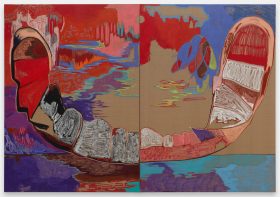Who hasn’t dreamt of running their own gallery or museum? To turn a vision based in idealism into reality? So it’s no surprise that Arts Management studies are amongst the most popular liberal arts and humanities courses for students around the world.
We live in an economically rationalist society that is obsessed with celebrity culture – an incongruous conflagration of ideals, which has led many young people who may previously have forged ahead as struggling artists, to opt for the (apparently) more secure career path of Arts Management.
By combining their passion for the Arts with an economically reliable, and transferable, administrative or management role, people are able to work in creatively stimulating atmospheres with like-minded, culturally aware people, while at the same time paying the mortgage on a three-bedroom house instead of the rent on a one-room studio and drinking wine from bottles rather than casks.
But is the promise of a career in Arts Management all it’s cracked up to be? What happens when the vision and passion of those engaged in cultural administration and arts management collides head-on with the ever-present bureaucratic imperative of tight financial control and administrative restrictions?
In other words, which comes first: artistic integrity or a healthy bottom line?
Famous, or Infamous, international cases…..
An infamous, perhaps the most infamous, case of conflict in arts management of recent years was that of the turmoil in management at London’s internationally renowned Covent Garden Opera. This fraught and complex issue has been thoroughly and impressively explored in Norman Lebrecht’s book, published in 2000:
Covent Garden, the Untold Story: Dispatches from the English Culture War, 1945–2000, by Norman Lebrecht. Boston: Northeastern University Press, 2000. [580 p. ISBN 1-55553-488-0. $37.50.]
Norman Lebrecht sums up the situation succinctly.
The Covent Garden case was, unfortunately, fairly typical of conflict at the top of international arts institutions. Ross Stretton, and the UK’s Royal Ballet, is another example. It’s hardly a rare occurrence, and has been the subject of some considered, and sometimes controversial, analysis. For some of the best, read A fish always rots from the head: some thoughts on leadership of cultural organisations.
The article, A fish always rots from the head… examines the delicate line that must be drawn between a board and the key personnel appointed to manage an institution. The ideal is to develop a team with complementary skills, but this is more easily said than done.
The paper Cruising Turbulence: Managing Conflict in the Arts Strategic Planning Process by Nancy Angelo, Ph.D makes the point however that conflict can be healthy. Angelo argues that the collaborative process that so often results in superb art, goes through stages of disagreement and constant redefinition. The same principle can be applied to the arts management planning process. She outlines a strategy and provides further exploration.
Similarly the International Journal of Arts Management, which is overseen by a truly international board of academics, practitioners and consultants, states that it:
And from the artist / academic point of view…
Moving forward in a time of fear, by Professor Margaret Seares is a paper she, delivered in Australia in 2003. In it, Margaret Seares, Pro ViceChancellor of the University of Western Australia, bemoans an anti-arts culture in Australia.
She should know – she is a past Chair of the Australia Council; a Member of Foreign Minister’s Australia International Cultural Council; Director of the Australian Foundation for Culture and Humanities; a Member of the Board of the National Portrait Gallery Past Appointments. She has held numerous arts-related positions prior to taking up these posts.
Almost to affirm Margaret Seares’ arguments, the Brian Kennedy and Dawn Casey case studies have left arts-loving Australians shaking their heads. Read An Australian Case Study: Negativity at the National Gallery of Australia for the details behind this controversy.
After seven tumultuous years at the head of the National Gallery of Australia, Irishman Dr. Brian Kennedy stood down in January 2004, following repeated conflicts with his own management team, and the administrative style of Australian cultural management.
The issue divided not only the arts community, but the public too.
For Kennedy’s own perspective, the interview he gave to the ABC affords some light into what happened and why.
In it Kennedy talks about the strengths and shortcomings of Australian culture and why the arts need to be incorporated as a central part of government policy. He gives his own spin on why his management style has not met with universal affection.
To be suspicious of an ‘outsider’ such as Kennedy might just be understandable, if not forgiveable, but the curious incident of the National Museum of Australia involves one of Australia’s very own. Dawn Casey, the first indigenous Director of a national institution in Australia, had her interpretation of that country’s history seriously questioned. And the price was her contract.
And in the Australian Music world…
During the same period as Dr Kennedy’s troubles, high-profile conductor Simone Young clashed calamitously with her bureaucratic employers at Opera Australia. More damage was done to OA than to Young’s career: she was quickly snapped up by the Hamburg Opera, calling into question the artistic wisdom of the board’s bottom line-driven decision. For Young’s own take on the incident, read The Age interview she gave at the time.
Pressure from the Top…
Despite the rapid global shift from social imperatives to commercial ones, the fact remains that the majority of high-profile arts management roles remain within large public institutions, generally under the auspices of government.
This can lead to the pressure of political interference in arts and cultural management, particularly in relation to the perceived ‘stacking’ of the boards of cultural institutions with political appointments. A recent high-profile instance of this was an appointment by the conservative Australian federal government to the board of the Australian Broadcasting Corporation (ABC) earlier this year.
Murdoch Press columnist Janet Albrechtsen, a trenchant critic of the nation’s premier public broadcaster, was a controversial appointment, which further signified, to some, the government’s agenda to undermine the independence and integrity of the ABC.
According to Fairfax journalist Annie Lawson, the ‘Federal Government… has struggled to tame what it views as a rebellious child. Despite hand-picking six of the current seven members of the national broadcaster’s nine member board, it still feels the ABC is out of control – hence its appointment to the board last week of Janet Albrechtsen. The appointment of the right-wing commentator, who has thrown many grenades at the broadcaster, has been perceived as putting the board on a war footing’.
See the background to the brouhaha HERE.
Is this issue unavoidable?
Frayed tempers and fractious relationships do seem endemic in cultural industries, as creative people struggle to operate within the confines of government bureaucracy and the increasing competition for often declining audiences.
An excellent source of information about the policies, practices and personalities that lead to conflict at the top of arts organisations is the Culturelink Network.
This page contains links to a range of organizations, including the International Network on Cultural Policy, The Council of Europe, and DIGICULT.
Culturelink also hosts a full listing of national institutions, research institutions and arts organizations throughout the world. It supplies links to various relevant publications and online resources – an invaluable resource.
For a quick look at the effects of policy, bureaucracy and financial pressure on arts and cultural organizations around the world, follow these links:
USA
The US ‘bible’ on the issue seems to be the International Journal of Arts Management, referred to earlier in this article. Only seven years old, IJAM, published three times a year, has quickly become indispensable to arts professionals and academics alike. Sample issues and subscription information is available on the website.
Also popular is the Journal of Arts Management, Law and Society, published by Washington-based Heldref Publications and available internationally.
Asia Pacific
For an in-depth study of various facets of management in the arts: contracts, logistics, organization, etc., see the online Asia Pacific Journal of Arts and Cultural Management.
This excellent and widely read journal features articles by leading arts management professionals, policy makers and academics on legal, political, artistic and administrative issues within the cultural industries of the Asia Pacific region.
UK
The Department of Cultural Policy and Management, at City University, London, is Europe’s largest interdisciplinary centre for arts, museums and heritage policy and management studies and research, and has a page of links to arts and cultural policy institutions throughout the UK.
Department of Cultural Policy and Management, at City University, London, is Europe’s largest interdisciplinary centre for arts, museums and heritage policy and management studies and research, and has a page of links to arts and cultural policy institutions throughout the UK.
The Department of Culture, Media and Sport (DCMS) is the British government’s departmental website.
See also the Arts Council of England site.
Canada
See the site of the Centre for Cultural Management at the University of Waterloo.
Still keen on a career in Arts Management?
Here are some courses to get you started…
Some of the most respected tertiary institutions in the US, UK and Australia now offer a variety of general and specialist courses in Arts and Cultural Management, the best of which include the following:
USA
John F. Kennedy Centre for the Performing Arts
Master of Arts Management Program
Core courses cover management, technology, financial, quantitative and communication skills within the context of creative enterprises in both the non-profit and for-profit sectors. Case studies, based on issues confronted by actual organizations, and guest speakers serve as the basis for analysis and discussion in many of the courses.
American University, College of Arts and Sciences, Department of Performing Arts
Study of various facets of management in the arts: contracts, logistics, organization, etc. Usually offered every fall.
UK
Arts & Event Management Training
London Southbank University
The BA (Hons) Arts Management is a three-year full-time degree that started in September 1997. The course aims to prepare students for a wide variety of careers in both commercial and publicly funded arts, media and cultural organisations. Arts management graduates are likely to work in areas such as artistic programming, education, policy, marketing, press, events, fundraising or administration in arts centres, festivals, theatres, orchestras, museums, galleries, dance companies, recording companies, or funding organisations. Graduates are also qualified to work for non-arts charities, particularly in the areas of administration, fundraising and marketing.
Department of Cultural Policy and Management
Europe’s largest interdisciplinary centre for arts, museums and heritage policy and management studies and research.
Australia
Western Australian Academy of Performing Arts
Queensland University of Technology
Master of Creative Industries (Arts Management & Creative Enterprise)
Melbourne University / Victorian College of the ArtsThe Master of Arts Management aims to prepare graduates for positions of leadership in a diversity of arts industry environments, ranging from large organizations and bureaucracies to self-employment, by imparting an understanding and appreciation of the arts, and the range of skills necessary to manage cultural resources, both human and material. The course consists of two years of full-time or equivalent study. The Master of Arts Management is offered jointly by the University of Melbourne and the Victorian College of the Arts.
Online
Online, Arts & Cultural Management
Someone’s got to do it, but don’t say that you weren’t warned.




